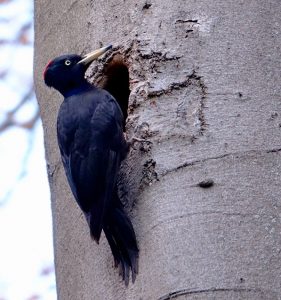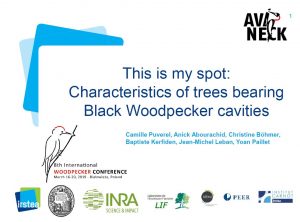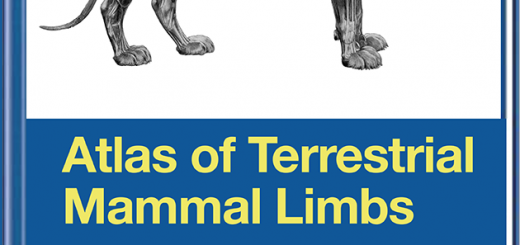Some like it soft! Publication on Black woodpecker ecology
 With a mean body mass of about 300g and a wingspan of about 70cm, the Black woodpecker (Dryocopus martius) is the largest woodpecker species in Eurasia. It feeds by using its bill to hammer on trees and also diggs hollows in trees (excavation) to build nests. The bird is regarded as the strongest excavator in Europe. The Black woodpecker is not only an ecosystem engineer that modifies its environment and provides new habitats for a multitude of large, secondary cavity users, but also an important umbrella species. Protecting an umbrella species indirectly protects the many other species that make up the ecological community of its habitat. This highlights the importance of knowing about the tree characteristics favorable for the Black woodpecker.
With a mean body mass of about 300g and a wingspan of about 70cm, the Black woodpecker (Dryocopus martius) is the largest woodpecker species in Eurasia. It feeds by using its bill to hammer on trees and also diggs hollows in trees (excavation) to build nests. The bird is regarded as the strongest excavator in Europe. The Black woodpecker is not only an ecosystem engineer that modifies its environment and provides new habitats for a multitude of large, secondary cavity users, but also an important umbrella species. Protecting an umbrella species indirectly protects the many other species that make up the ecological community of its habitat. This highlights the importance of knowing about the tree characteristics favorable for the Black woodpecker.

In their study Puverel et al. Forest Ecology and Management were interested to identify the specific features of the trees excavated by the Black woodpecker. We went to the woods to collect quantitative data in order to better understand the relationships between the birds and the structure of their habitat.
Puverel C, Abourachid A, Böhmer C, Leban J-M, Svoboda M and Paillet Y (2019) This is my spot: what are the characteristics of the trees excavated by the Black Woodpecker? A case study in two managed French forests. Forest Ecology and Management 453: 117621. DOI: 10.1016/j.foreco.2019.117621.
Böhmer C, Fasquelle B, Furet M, Wenger P, Abourachid A (2019). Combining precision and power to maximize performance: a case study of the woodpecker’s neck. Computer Methods in Biomechanics and Biomedical Engineering: Supplement for the International French Society of Biomechanics 2019 Conference, Poitiers, France.




Neueste Kommentare